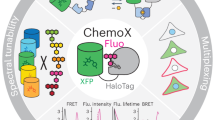Abstract
Fluorescence lifetime-based chemical sensors have recently been described for applications in medicine, environmental monitoring, and bioprocess control. These sensors transduce the level of the analyte as a change in the apparent fluorescence lifetime of an indicator phase. We have previously developed a wavelength-ratiometric fluorescence biosensor for zinc based on binding of zinc and dansylamide to apo-carbonic anhydrase which exhibited high sensitivity and selectivity. We demonstrate that the apo-carbonic anhydrase/dansylamide indicator system is very well suited for lifetime-based sensing, with a subnanomolar detection limit and greater than 1000-fold dynamic range. The theoretical basis for the wide dynamic range is discussed.
Similar content being viewed by others
References
R. B. Thompson (1991) in J. R. Lakowicz (Ed.),Topics in Fluorescence Spectroscopy Vol. II: Principles, Plenum Press, New York, pp. 345–365.
O. S. Wolfbeis (Ed.) (1991)Fiber Optic Chemical Sensors and Biosensors, Vols. 1 and 2, CRC Press, Boca Raton, FL.
D. Wise and L. Wingard (Eds.) (1991)Biosensors with Fiber Optics, Humana Press, Clifton, NJ.
S. M. Angel (1987)Spectroscopy 2(4), 34–38.
C. Goyet, D. R. Walt, and P. G. Brewer (1992)Deep-Sea Res. 39, 1015–1026.
S. Divers, S. D. Riccitelli, and M. Blais (1993) in F. P. Milanovich (Ed.),Fiber Optic Sensors in Medical Diagnostics: SPIE Vol. 1886, SPIE, Bellingham, WA, pp. 111–138.
R. B. Thompson and E. R. Jones (1993)Anal. Chem. 65, 730–734.
R. Y. Tsien (1989)Annu. Rev. Neurosci. 12, 227.
S. Lindskoget al. (1971) in P. Boyer (Ed.),The Enzymes, Vol. 5, Academic Press, New York, pp. 587–665.
S. J. Dodgsonet al. (Eds.) (1991)The Carbonic Anhydrases, Plenum Press, New York.
J. E. Coleman (1965)Biochemistry 4, 2644–2655.
R. F. Chen and J. C. Kernohan (1967)J. Biol. Chem. 242, 5813–5823.
J. Wages, K. Hirshfield, and L. Brand (1987)Biophys. J. 51, 284A.
S. M. Keating and T. G. Wensel (1991)Biophys. J. 59, 186–202.
J. R. Bacon and J. N. Demas (1987)Anal. Chem. 59, 2780–2785.
J. R. Lakowicz (1992)Laser Focus 28(5), 60–80.
J. R. Lakowicz and R. B. Thompson (Eds.) (1993)Advances in Fluorescence Sensing Technology I: SPIE Proc. Vol. 1885, SPIE, Bellingham, WA.
M. E. Lippitsch, J. Pusterhofer, M. J. P. Leiner, and O. S. Wolfbeis (1988)Anal. Chim. Acta 205, 1–6.
J. R. Lakowicz, H. Szmacinski, and R. B. Thompson (1993) in G. Cohn (Ed.),Ultrasensitive Laboratory Diagnostics: Proc. SPIE Vol. 1895, SPIE, Bellingham, WA, pp. 2–17.
J. R. Lakowicz and B. P. Maliwal (1993)Anal. Chim. Acta 271, 155–164.
H. Szmacinski and J. R. Lakowicz (1993)Anal. Chem. 65, 1668–1674.
R. B. Thompson, J. K. Frisoli, and J. R. Lakowicz (1993)Anal. Chem. 64, 2075–2078.
K. Berndt (1987)Measurement 5(4), 159–166.
R. B. Thompson and M. W. Patchan (1994) in R. Lieberman (Ed.),Chemical, Biochemical, and Environmental Fiber Sensors V: Proc. SPIE Vol. 2068, SPIE, Bellingham, WA, pp. 296–306.
G. Weber (1993)Protein Interactions, Chapman and Hall, London.
J. R. Lakowicz and I. Gryczynski (1991) in J. R. Lakowicz (Ed.),Topics in Fluorescence Spectroscopy Vol. 1: Techniques, Plenum Press, New York, pp. 293–335.
J. R. Lakowicz, H. Szmacinski, and M. L. Johnson (1992)J. Fluoresc. 2, 47–52.
Y. Pocker and C. T. O. Fong (1983)Biochemistry 22, 813–818.
P. L. Whitney (1974)Anal. Biochem. 57, 467–476.
R. B. Thompson and E. Gratton (1988)Anal. Chem. 60, 670–674.
E. Gratton, M. Limkeman, J. R. Lakowicz, B. P. Maliwal, H. Cherek, and G. Laczko (1984)Biophys. J. 46, 479–486.
K. W. Bruland (1988)Appl. Geochem. 3, 75.
J. R. Lakowicz and H. Cherek (1981)J. Biol. Chem. 256, 6348–6353.
B. G. Pinsky, J. J. Ladasky, J. R. Lakowicz, K. Berndt, and R. A. Hoffman (1993)Cytometry 14, 123–135.
B. W. Smith, B. T. Jones, and J. D. Winefordner (1988)Appl. Spectrosc. 42, 1469–1472.
Author information
Authors and Affiliations
Rights and permissions
About this article
Cite this article
Thompson, R.B., Patchan, M.W. Fluorescence lifetime-based biosensing of zinc: Origin of the broad dynamic range. J Fluoresc 5, 123–130 (1995). https://doi.org/10.1007/BF00727528
Issue Date:
DOI: https://doi.org/10.1007/BF00727528




